A Machine Learning Model Relating Xrain and Rain Gauge †
Abstract
:1. Introduction
2. Research Location, Data and Methods
2.1. Research Location
2.2. Data and Method
2.3. Data Preparation
2.4. Model Building
3. Results and Discussion
4. Conclusions
Author Contributions
Funding
Institutional Review Board Statement
Informed Consent Statement
Data Availability Statement
Acknowledgments
Conflicts of Interest
References
- Gomez, C.; Lavigne, F.; Lespinasse, N.; Hadmoko, D.S.; Wassmer, P. Longitudinal structure of pyroclastic-flow deposits, revealed by GPR survey, at Merapi Volcano, Java, Indonesia. J. Volcanol. Geotherm. Res. 2008, 176, 439–447. [Google Scholar] [CrossRef]
- Gomez, C.; Lavigne, F.; Hadmoko, D.S.; Lespinasse, N.; Wassmer, P. Block-and-ash flow deposition: A conceptual model from a GPR survey on pyroclastic-flow deposits at Merapi Volcano, Indonesia. Geomorphology 2009, 110, 118–127. [Google Scholar] [CrossRef]
- Burgisser, A.; Bergantz, G.W. Reconciling pyroclastic flow and surge: The multiphase physics of pyroclastic density currents. Earth Planet. Sci. Lett. 2002, 202, 405–418. [Google Scholar] [CrossRef]
- Girolami, L.; Druit, T.H.; Roche, O. Towards a quantitative understanding of pyroclastic flows: Effects of expansion on the dynamics of laboratory fluidized granular flows. J. Volcanol. Getherm. Res. 2015, 296, 31–39. [Google Scholar] [CrossRef]
- Beget, J.; Gardner, C.; Davis, K. Volcanic tsunamis and prehistoric cultural transitions in Cook Inlet, Alaska. J. Volcanol. Geotherm. Res. 2008, 176, 377–386. [Google Scholar] [CrossRef]
- Lavigne, F.; Thouret, J.-C.; Voight, B.; Young, K.; LaHusen, R.; Marso, J.; Suwa, H.; Sumaryono, A.; Sayudi, D.S.; Dejean, M. Instrumental lahar monitoring at Merapi Volcano, Central Java, Indonesia. J. Volcanol. Geotherm. Res. 2000, 100, 457–478. [Google Scholar] [CrossRef]
- Lavigne, F.; Thouret, J.C.; Voight, B.; Suwa, H.; Sumaryono, A. Lahars at Merapi Volcano, Central Java: An overview. J. Volcanol. Geotherm. Res. 2000, 100, 423–456. [Google Scholar] [CrossRef]
- Starheim, C.A.; Gomez, C.; Davies, T.; Lavigne, F.; Wassmer, P. In-flow evolution of lahar deposits from video-imagery with implications for post-event deposit interpretation, Mount Semeru, Indonesia. J. Volcanol. Geotherm. Res. 2013, 256, 96–104. [Google Scholar] [CrossRef]
- Gomez, C.; Lavigne, F.; Hadmoko, D.S.; Wassmer, P. Insights into lahar deposition processes in the Curah Lengkong (Semeru Volcano, Indonesia) using photogrammetry-based geospatial analysis, near-surface geophysics and CFD modelling. J. Volcanol. Geotherm. Res. 2018, 353, 102–113. [Google Scholar] [CrossRef]
- Vazquez, R.; Capra, L.; Caballero, L.; Arambula-Mendoza, R.; Reyes-Davila, G. The anatomy of a lahar: Deciphering the 15th September 2012 lahar at Volcan de Colima, Mexico. J. Volcanol. Geotherm. Res. 2014, 272, 126–136. [Google Scholar] [CrossRef]
- Caballero, L.; Capra, L. The use of FLO2D numerical code in lahar hazard evaluation at Popocatepetl volcano: A 2001 lahar scenario. Nat. Hazards Earth Syst. Sci. 2014, 14, 3345–3355. [Google Scholar] [CrossRef]
- Pistolesi, M.; Cioni, R.; Rosi, M.; Aguilera, E. Lahar hazard assessment in the southern drainage system of Cotopaxi volcano, Ecuador: Results from multiscale lahar simulations. Geomorphology 2014, 207, 51–63. [Google Scholar] [CrossRef]
- De Belizal, E. Lahar-related impacts after the 2010 eruption of Merapi Volcano (Java, Indonesia). Geomorphol. Relief Process. Environ. 2013, 4, 463–480. [Google Scholar] [CrossRef]
- Gomez, C.; Lavigne, F. Transverse architecture of lahar terraces, inferred from radargrams: Preliminary results from Semeru Voclano, Indonesia. Earth Surf. Process. Landf. 2010, 35, 1116–1121. [Google Scholar] [CrossRef]
- Lavigne, F.; Tirel, A.; Le Floch, D.; Veryat-Charvillon, S. A real-time assessment of lahar dynamics and sediment load based on video-camera recording at Semeru Volcano, Inodnesia. In Debris-Flow Hazards Mitigation: Mechanics, Prediction, and Assessment; Rickenmann, D., Chenn, C., Eds.; Millpress Science Publishers: Rotterdam, The Netherlands, 2003; Volumes 1 and 2, pp. 871–882. [Google Scholar]
- Syarifuddin, M.; Hapsari, R.I.; Legono, D.; Oishi, S.; Mawanda, H.G.; Aisyah, N.; Shimomura, M.; Nakamichi, H.; Iguchi, M. Monitoring the rainfall intensity at two active volcanoes in Indonesia and Japan by small-compact X-band radars. IOP Earth Environ. Sci. 2020, 437, 012040. [Google Scholar] [CrossRef]
- Hapsari, R.I.; Oishi, S.; Syarifuddin, M.; Asmara, R.A.; Legono, D. X-MP Radar for Developing a Lahar Rainfall Threshold for the Merapi Volcano Using a Bayesian Approach. J. Disaster Res. 2019, 14, 811–828. [Google Scholar] [CrossRef]
- Nastos, P.T.; Moustris, K.P.; Larissi, I.K.; Paliatsos, A.G. Rain intensity forecast using Artificial Neural Networks in Athens, Greece. Atmos. Res. 2013, 119, 153–160. [Google Scholar] [CrossRef]



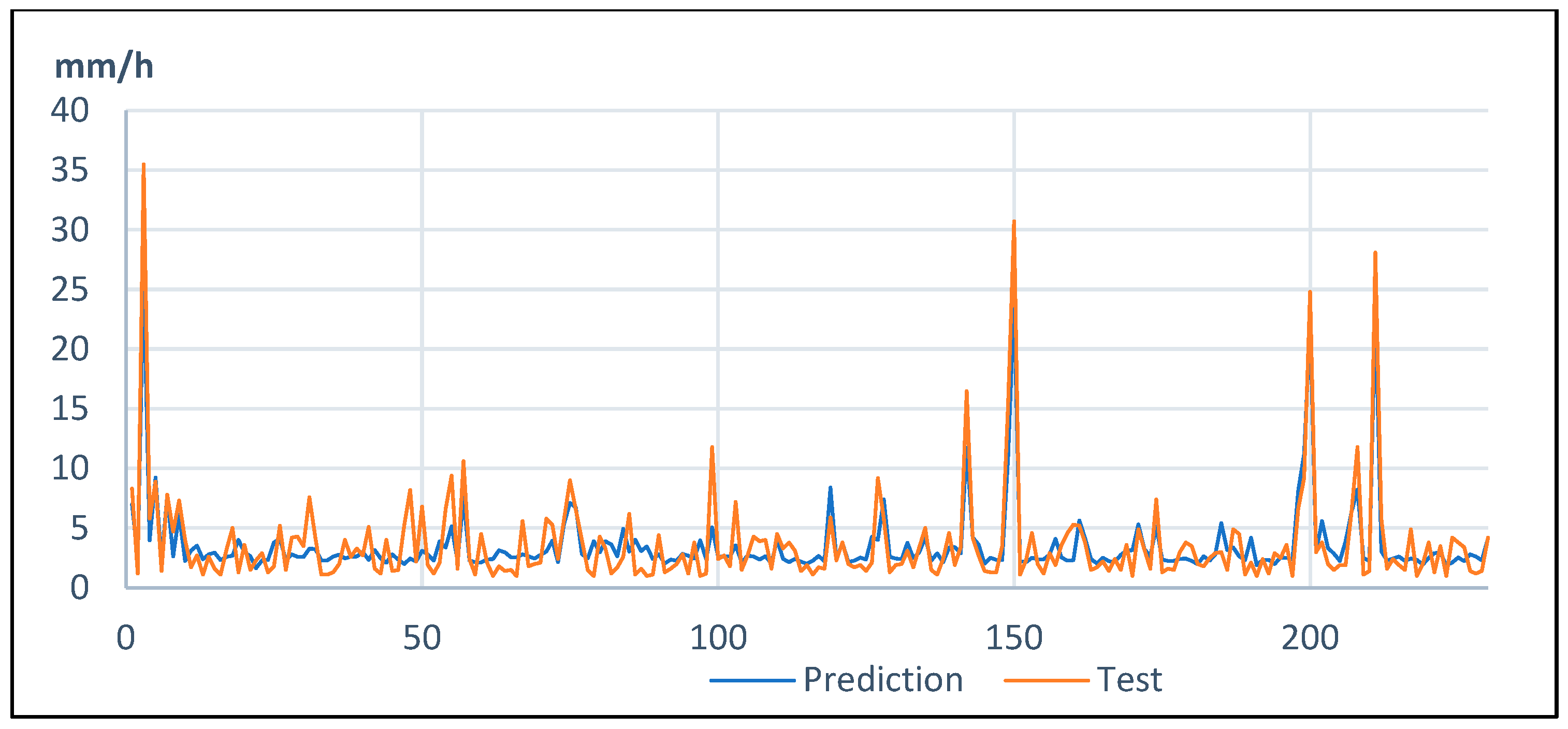

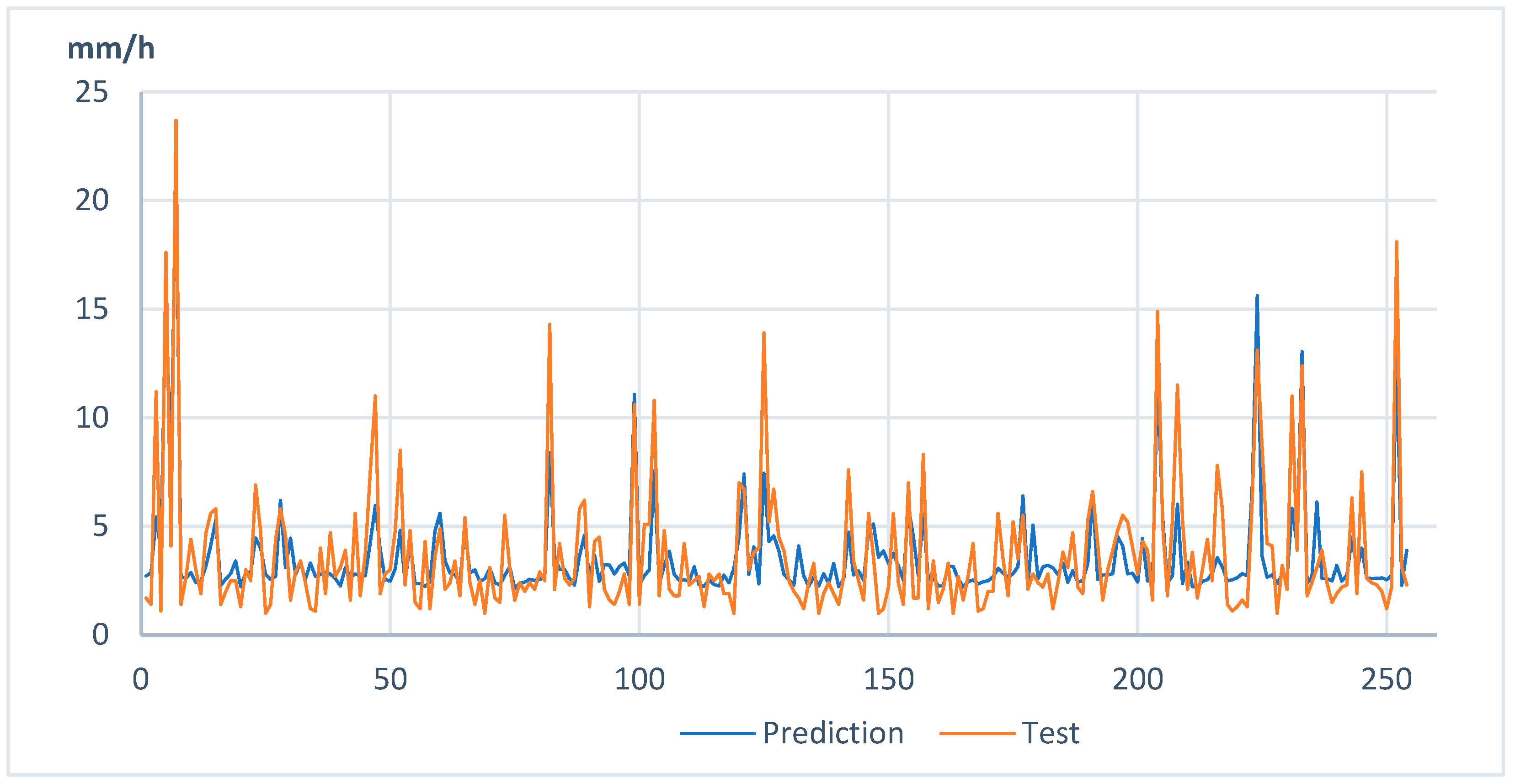
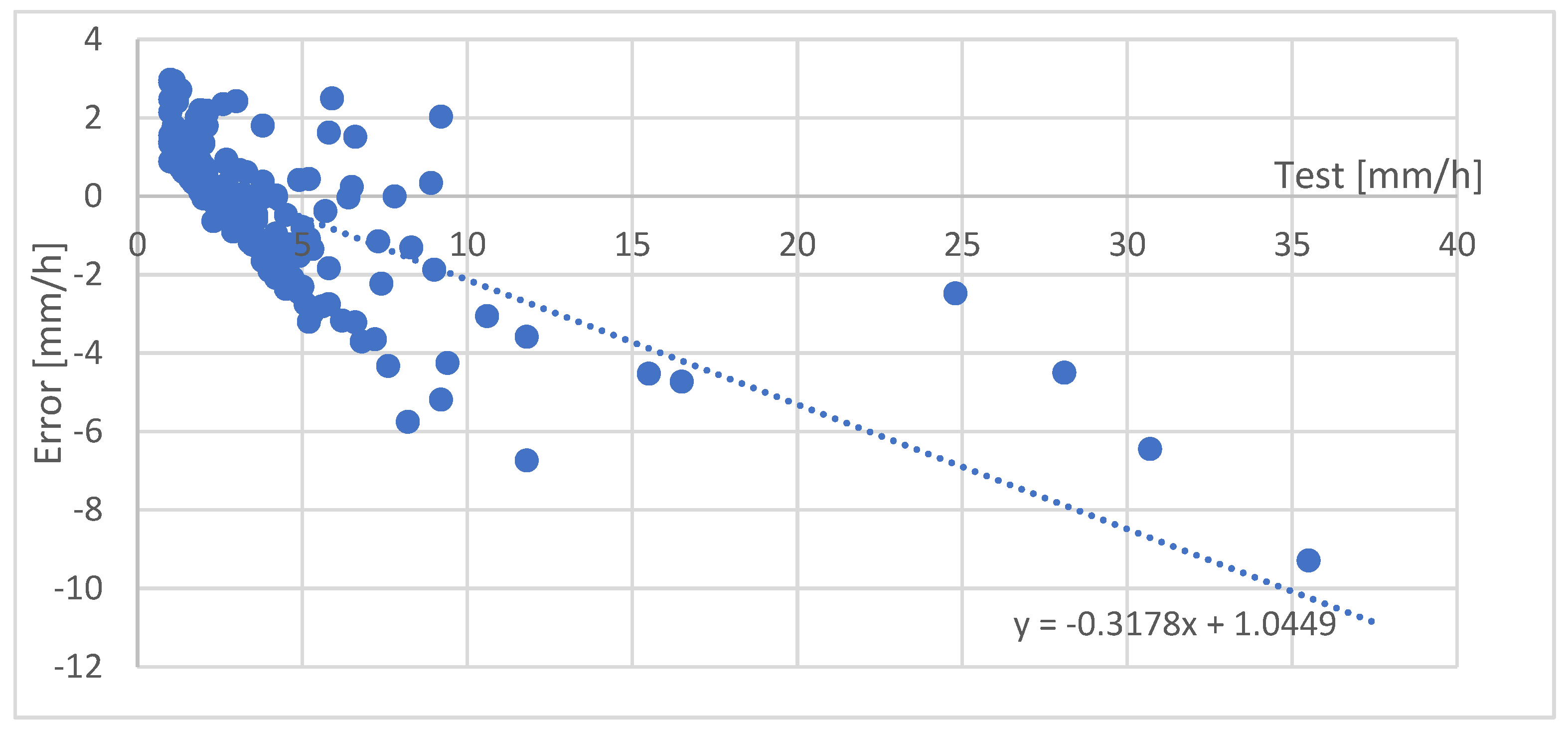
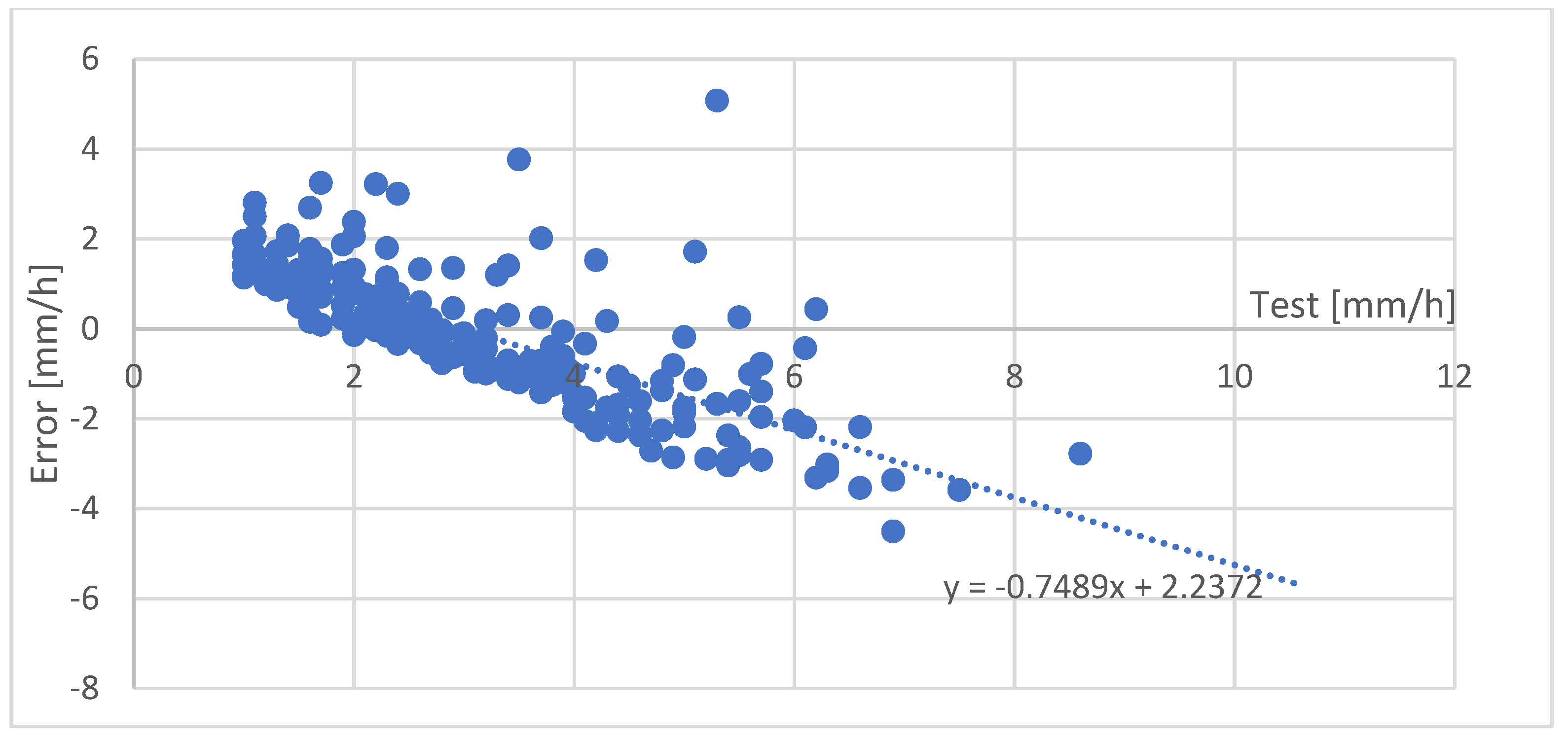
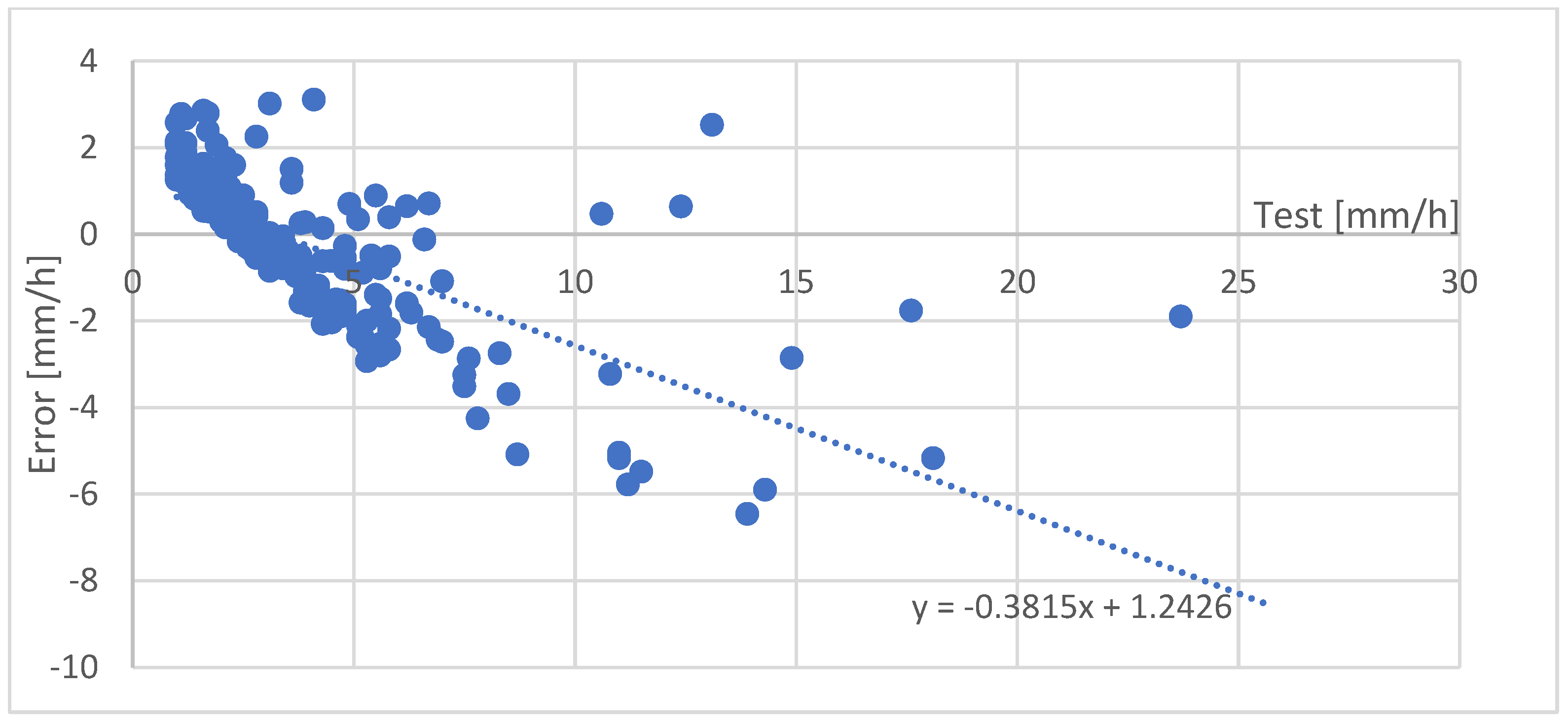
| Parameter | Value or Function |
|---|---|
| η | 0.0005 |
| λ | Z-Score |
| L | Input + Hidden × 2 + Output |
| j | 32, 32, 32 |
| batch | 32 |
| ECHO (U, K, S) 1 | 300, 120, 130 |
| Loss | MSE |
| optimizer | SGD |
| activation | sigmoid |
Disclaimer/Publisher’s Note: The statements, opinions and data contained in all publications are solely those of the individual author(s) and contributor(s) and not of MDPI and/or the editor(s). MDPI and/or the editor(s) disclaim responsibility for any injury to people or property resulting from any ideas, methods, instructions or products referred to in the content. |
© 2022 by the authors. Licensee MDPI, Basel, Switzerland. This article is an open access article distributed under the terms and conditions of the Creative Commons Attribution (CC BY) license (https://creativecommons.org/licenses/by/4.0/).
Share and Cite
Zhang, M.; Gomez, C.; Bradak, B.; Norifumi, H.; Yoshinori, S. A Machine Learning Model Relating Xrain and Rain Gauge. Proceedings 2023, 87, 11. https://doi.org/10.3390/IECG2022-13828
Zhang M, Gomez C, Bradak B, Norifumi H, Yoshinori S. A Machine Learning Model Relating Xrain and Rain Gauge. Proceedings. 2023; 87(1):11. https://doi.org/10.3390/IECG2022-13828
Chicago/Turabian StyleZhang, Miao, Christopher Gomez, Balazs Bradak, Hotta Norifumi, and Shinohara Yoshinori. 2023. "A Machine Learning Model Relating Xrain and Rain Gauge" Proceedings 87, no. 1: 11. https://doi.org/10.3390/IECG2022-13828
APA StyleZhang, M., Gomez, C., Bradak, B., Norifumi, H., & Yoshinori, S. (2023). A Machine Learning Model Relating Xrain and Rain Gauge. Proceedings, 87(1), 11. https://doi.org/10.3390/IECG2022-13828







